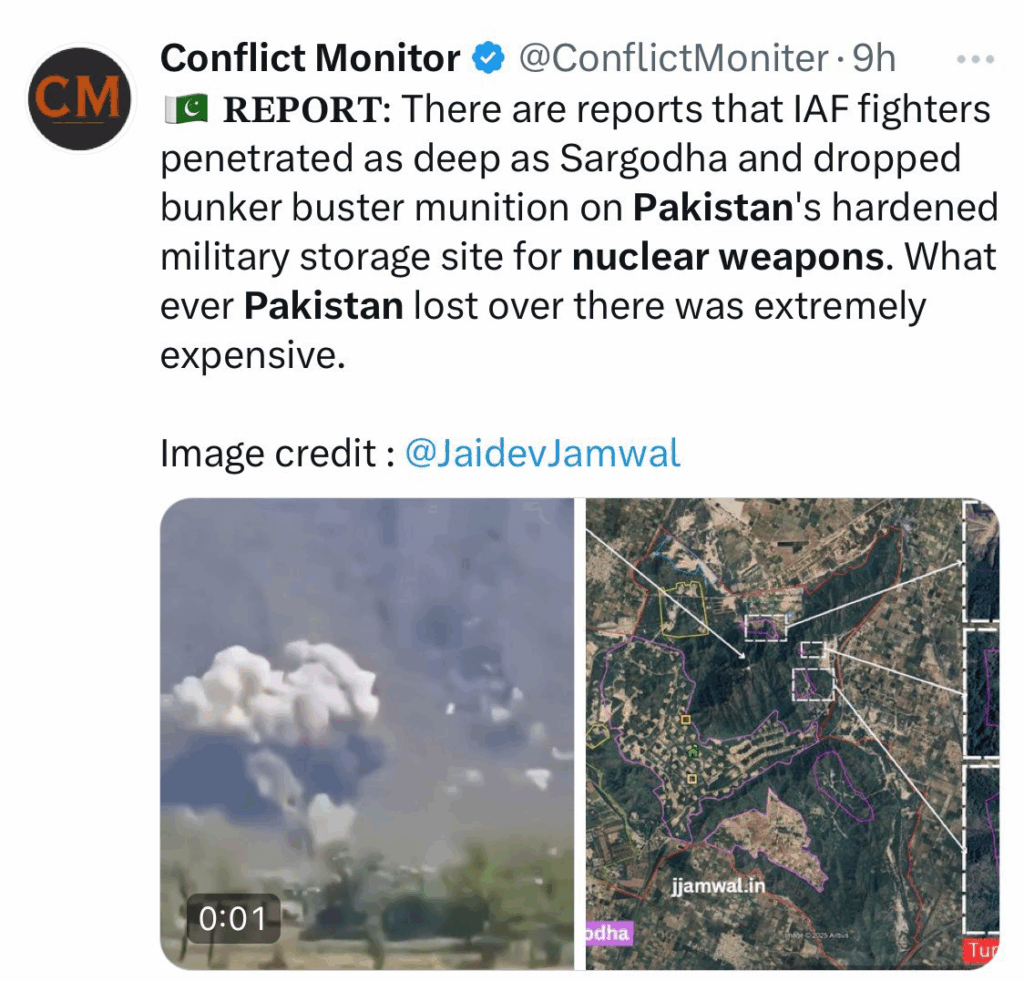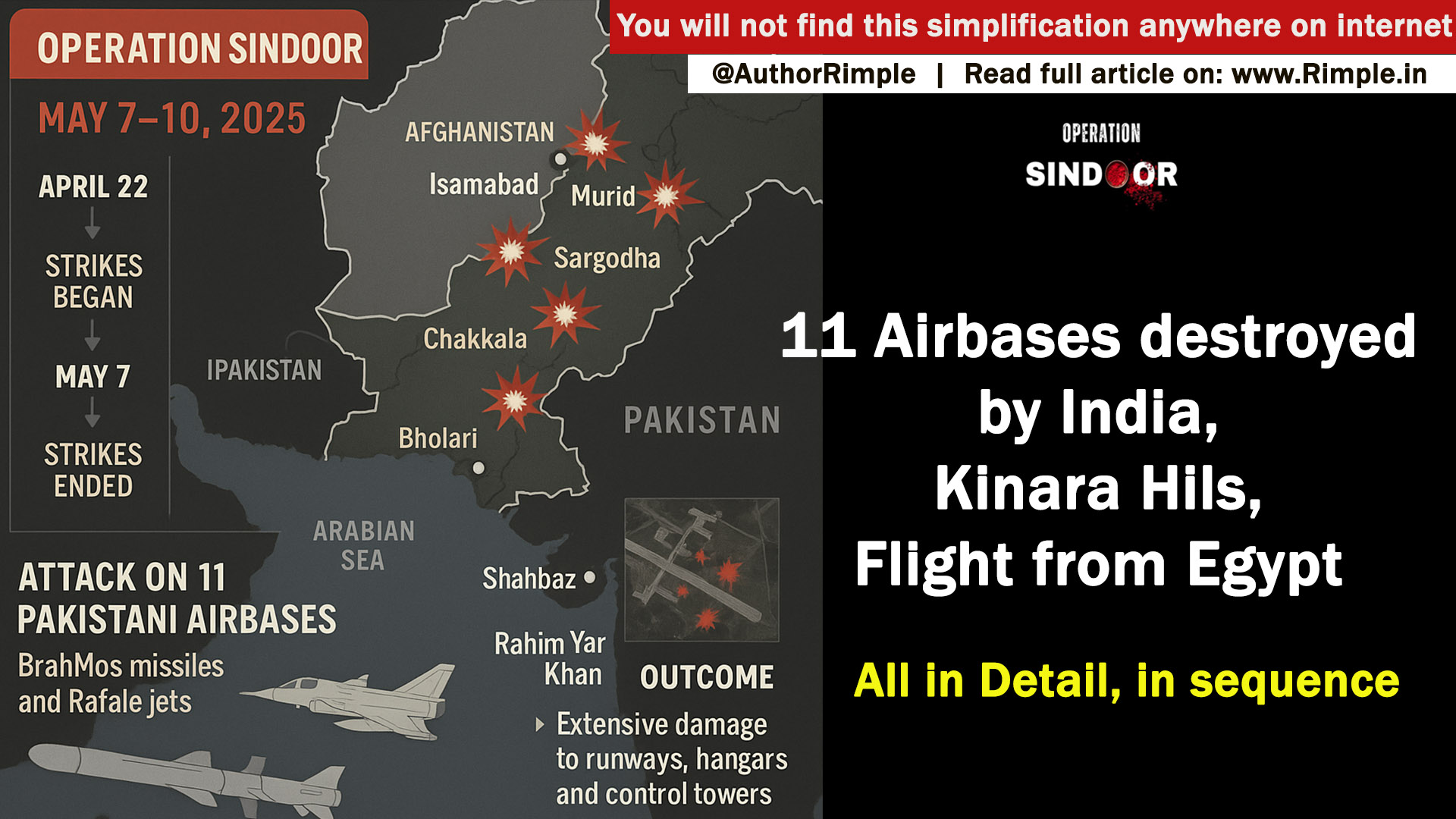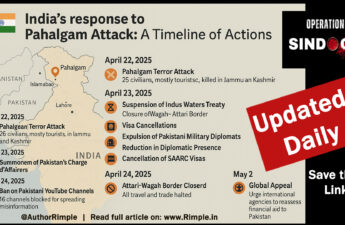On the morning of May 7, 2025, India launched a military operation that would shake the foundations of Pakistan’s defense and send ripples across the world. Named Operation Sindoor, this was India’s bold response to a horrific terror attack on April 22 in Pahalgam, Jammu and Kashmir, where 26 civilians, mostly Hindu tourists, lost their lives to Pakistan-backed Lashkar-e-Taiba terrorists. By May 10, India had delivered a crushing blow, destroying 11 of Pakistan’s key airbases in a 90-minute blitz, exposing the fragility of Pakistan’s military and its so-called nuclear might. This is the story of India’s strategic brilliance, Pakistan’s humiliating defeat, and the desperate ceasefire plea that followed.
The Spark: Pahalgam Terror Attack
On April 22, 2025, at 3:00 PM IST, terrorists struck Pahalgam, killing 26 civilians in a cowardly attack. India’s intelligence agencies quickly traced the assault to Lashkar-e-Taiba, operating from safe havens in Pakistan. For weeks, India offered dialogue, urging Pakistan to dismantle terror camps. But Pakistan, emboldened by its Chinese and Turkish allies, ignored the calls. On May 6, Pakistan escalated tensions, launching drones and missiles at 15 Indian airfields and civilian sites, killing 16 civilians and damaging religious structures. This was the final straw.
May 7-8, 2025: Operation Sindoor Begins
At 2:00 AM IST on May 7, India’s armed forces, led by the Indian Air Force (IAF), launched Operation Sindoor. The mission was clear: neutralize Pakistan’s terror infrastructure and cripple its military capabilities. India targeted nine terror camps in Pakistan and Pakistan-occupied Kashmir (PoK), using precision-guided munitions to avoid civilian casualties. Pakistan, caught off-guard, scrambled to respond, but its Chinese-made HQ-9 air defense systems and Turkish Bayraktar TB2 drones proved woefully inadequate. Social media posts mocked Pakistan’s “world-class” arsenal, with one X user quipping, “China’s missiles and Turkey’s drones turned out to be fancy firecrackers!”
May 8-10, 2025: The Airbase Annihilation
By May 8, India shifted gears, targeting Pakistan’s military backbone—its airbases. Over three days, from 1:00 AM on May 8 to 4:00 PM on May 10, the IAF executed precision strikes on 11 airbases, obliterating runways, hangars, radars, and command centers. Satellite imagery from Bengaluru-based Kawa Space confirmed the devastation, showing craters and debris across Pakistan’s prized military installations. Here’s a detailed breakdown of the 11 airbases, their significance, and the message India sent with each strike:
- Nur Khan Airbase (Chaklala), Rawalpindi
- Date/Time: May 8, 1:30 AM IST
- Significance: Located just 10 km from Islamabad, Nur Khan is Pakistan’s logistical lifeline, housing C-130 Hercules transport planes, IL-78 mid-air refuelers, and VIP aircraft. It’s also perilously close to the Strategic Plans Division, Pakistan’s nuclear command hub.
- Impact: India’s missile strike on the main runway and hangars crippled Pakistan’s airlift capabilities. The proximity to the nuclear command center sent a chilling message: India could decapitate Pakistan’s nuclear authority if pushed. Pakistan’s leadership, reportedly hiding in bunkers, was left trembling.
- Rafiqui Airbase, Shorkot
- Date/Time: May 8, 2:00 AM IST
- Significance: Situated in Punjab’s Jhang district, Rafiqui is a key fighter base with Mirage and JF-17 squadrons, critical for operations against India’s Punjab and Kashmir. It also serves as a training hub.
- Impact: India’s BrahMos missiles obliterated the 10,000-foot runway and hangars, grounding Pakistan’s fighter jets. Over 50 personnel, including Squadron Leader Usman Yousuf, were killed, dealing a blow to Pakistan’s morale.
- Murid Airbase, Chakwal
- Date/Time: May 8, 2:15 AM IST
- Significance: Murid is Pakistan’s drone warfare hub, operating Turkish Bayraktar TB2 and Shahpar-I UAVs. It’s a cornerstone of Pakistan’s surveillance and strike capabilities.
- Impact: India’s strikes destroyed drone launch pads and command centers, rendering Pakistan’s drone fleet useless. The failure of Turkish drones was mocked online, with one user joking, “Turkey’s TB2s couldn’t even buzz a fly!”
- Sukkur Airbase, Sindh
- Date/Time: May 8, 3:00 AM IST
- Significance: Located between Karachi and Hyderabad, Sukkur houses the 41 Tactical Wing, with F-16 and JF-17 squadrons, and Swedish Erieye early-warning aircraft. It’s vital for operations in Sindh and Balochistan.
- Impact: India’s precision strikes cratered the runway and destroyed hangars, disrupting Pakistan’s southern air operations. The loss of early-warning systems left Pakistan blind.
- Sialkot Airbase
- Date/Time: May 8, 3:30 AM IST
- Significance: A forward operating base near the Indian border, Sialkot supports rapid deployment of fighters and drones for cross-border operations.
- Impact: India’s missiles demolished radar sites and aviation facilities, crippling Pakistan’s ability to monitor Indian airspace.
- Pasrur Airstrip
- Date/Time: May 8, 4:00 AM IST
- Significance: A smaller but critical airstrip for emergency aircraft dispersal, Pasrur enhances Pakistan’s operational flexibility near the border.
- Impact: India’s strike rendered the airstrip inoperable, forcing Pakistan to consolidate aircraft at vulnerable bases, exposing them to further attacks.
- Chunian Airbase, Punjab
- Date/Time: May 8, 4:30 AM IST
- Significance: A frontline operational base in central Punjab, Chunian supports drone and fighter operations close to India’s border.
- Impact: India’s missiles created a massive crater in the runway, halting operations and sending a message about India’s reach into Pakistan’s heartland.
- Sargodha (Mushaf) Airbase
- Date/Time: May 9, 2:00 AM IST
- Significance: Located 200 km west of Amritsar, Mushaf is Pakistan’s elite airbase, housing F-16, JF-17, and Mirage squadrons, the Combat Commanders School, and the Central Air Command. It’s linked to underground nuclear storage sites in the nearby Kirana Hills, just 20 km away, a fortified zone with tunnels for nuclear warheads.
- Impact: India’s loitering munitions and bunker-busting bombs struck the runway and hangars, causing extensive damage. The strike on Sargodha was a masterstroke, signaling India’s knowledge of Pakistan’s nuclear sites. By targeting Mushaf, India indirectly warned, “We know where your nukes are, and we can reach them.” Social media buzzed with unconfirmed claims of a hit on Kirana Hills’ tunnel entrances, amplifying Pakistan’s panic.
- Skardu Airbase, PoK
- Date/Time: May 9, 3:00 AM IST
- Significance: Located in Pakistan-occupied Kashmir, Skardu is a high-altitude base for surveillance and operations near the Line of Actual Control (LAC), often coordinating with Chinese forces.
- Impact: India’s strikes neutralized Skardu’s logistical links, disrupting Pakistan-China coordination and weakening Pakistan’s northern defenses.
- Bholari Airbase
- Date/Time: May 10, 2:00 AM IST
- Significance: A modern base in Sindh, Bholari houses quick-reaction alert hangars and JF-17 squadrons, critical for rapid response in southern Pakistan.
- Impact: India’s BrahMos missiles demolished a key hangar, with debris visible in Kawa Space imagery. The strike killed over 50 personnel, further denting Pakistan’s air force.
- Jacobabad (Shahbaz) Airbase
- Date/Time: May 10, 3:00 AM IST
- Significance: Located in northern Sindh, Jacobabad hosts F-16 and JF-17 squadrons, a search-and-rescue unit, and is a key base opposite India’s Rajasthan.
- Impact: India’s precision strikes hit hangars and the air traffic control building, crippling Pakistan’s operational readiness in the region.
The Kirana Hills Connection
The strike on Mushaf Airbase in Sargodha was the most significant. Just 20 km away lies Kirana Hills, a 68 sq km fortified zone with 10 reinforced tunnels, believed to house Pakistan’s nuclear warheads. India’s official stance, articulated by Air Marshal AK Bharti on May 12, was a sarcastic denial: “Thank you for telling us Kirana Hills has nuclear installations. We didn’t know, and we didn’t hit it.” Yet, satellite imagery and social media leaks suggested precision strikes near tunnel entrances, fueling speculation that India targeted the nuclear storage site as a warning. The message was clear: India knows Pakistan’s nuclear secrets and can neutralize them if needed. Pakistan’s silence on the matter spoke volumes, as its leadership avoided mentioning Kirana Hills, fearing further exposure of their vulnerabilities.

US Rushes Boron to Pakistan: India’s Nuclear Slap
On May 11, 2025, at approximately 2:00 AM IST, an Egyptian Air Force IL-76 cargo plane, identified as EGY1916, landed in Rawalpindi, Pakistan, carrying an emergency shipment of boron, a substance used for containing or suppressing radioactive leaks. Egypt has the highest source of Boron. Flight tracking data from Flightradar24, widely shared on social media, confirmed the plane’s departure from Egypt’s boron-rich Nile Delta and its urgent mission to Pakistan. Hours earlier, a US Department of Energy (DoE) Beechcraft B350 aircraft (registration N111SZ) was spotted circling near Islamabad and Sargodha, equipped with sensors to detect radioactive contamination. Though neither the US nor Pakistan officially confirmed the purpose, defense analysts and online reports pointed to one undeniable conclusion: India’s precision strike on Kirana Hills, just 20 km from Mushaf Airbase in Sargodha, had hit Pakistan’s nuclear storage facility, triggering a radioactive scare.

Pakistan, which has long brandished its nuclear arsenal with boasts of being an untouchable “nuclear power,” was left red-faced. India’s bunker-busting munitions, likely deployed during the May 9 strike on Sargodha, penetrated the reinforced tunnels of Kirana Hills, where Pakistan stores its nuclear warheads. Unverified satellite imagery and videos from Pakistani locals, circulating on X, showed smoke and debris near tunnel entrances, fueling speculation of significant damage. The arrival of the Egyptian plane with boron—used to suppress nuclear radiation—and the US DoE’s radiation-monitoring aircraft underscored the severity of the strike. One X post mockingly declared, “Pakistan’s nuclear threats turned to dust, and now they’re begging for boron to clean up India’s mess!”

India’s strike was a calculated masterstroke, exposing Pakistan’s nuclear bluff. For years, Islamabad has threatened nuclear retaliation to deter India, but Operation Sindoor shattered that myth. By targeting Kirana Hills, India sent a resounding message: “Your nuclear toys are no match for our precision and resolve.” The Indian government maintained strategic silence, with Air Marshal AK Bharti sarcastically denying knowledge of Kirana Hills’ nuclear significance, but the global frenzy—amplified by the US and Egyptian response—confirmed India’s dominance. Pakistan’s nuclear bravado lay in ruins, its leadership humiliated as India slapped them on their own turf, proving that no fortress, not even Kirana Hills, is beyond India’s reach.
Pakistan’s Desperate Response
By May 10, 6:00 PM IST, Pakistan’s military was in shambles, with 20% of its air force infrastructure reduced to rubble, radars destroyed, and elite squadrons grounded. Pakistan’s arsenal of foreign-supplied ammunition—China’s PL-15 missiles, Turkey’s MAM-L smart munitions for Bayraktar TB2 drones, France’s SCALP-EG cruise missiles for Mirage jets, and US-supplied AIM-120 AMRAAMs—proved utterly useless against India’s superior defenses. Social media erupted with ridicule, with one X post jeering, “China’s missiles fizzled, Turkey’s bombs flopped, and US and French ammo couldn’t even scratch India’s Akashteer shield!” The overhyped Chinese and Turkish munitions, along with US and French supplies, became a global embarrassment, exposing Pakistan’s reliance on subpar foreign junk.
Pakistan’s army chief, Asim Munir, was reportedly cowering in a bunker during the Nur Khan airbase strike near Islamabad, a fact Indian media highlighted to underscore Pakistan’s panic. At 8:00 PM IST on May 10, Prime Minister Shehbaz Sharif convened an emergency meeting of the National Command Authority, Pakistan’s nuclear oversight body, though Islamabad later denied it. The strikes on Nur Khan, near the Strategic Plans Division, and Sargodha, close to the Kirana Hills nuclear storage site, had rattled Pakistan’s leadership to its core. Fearing further devastation and India’s clear ability to target sensitive sites, Pakistan scrambled to initiate ceasefire talks.
On May 10, US Secretary of State Marco Rubio contacted Pakistan’s army chief Asim Munir and Indian External Affairs Minister S Jaishankar, as confirmed by the US State Department and Indian government sources. Rubio’s call to Jaishankar focused on de-escalation, with Jaishankar reiterating India’s restrained yet firm response to Pakistan’s terrorism. US Vice President JD Vance also spoke with Prime Minister Narendra Modi, conveying Pakistan’s desperation to end hostilities. On May 11, at 3:35 PM IST, Pakistan’s Director General of Military Operations (DGMO) made a frantic call to India’s DGMO, begging for a ceasefire, as confirmed by Foreign Secretary Vikram Misri in a press briefing. The Indian Ministry of External Affairs (MEA) and Government of India (GOI) emphasized that Pakistan, not India, initiated the ceasefire talks, driven by the catastrophic losses from India’s relentless strikes.
The ceasefire was agreed upon at 5:00 PM IST, but Pakistan’s desperation was short-lived, as it violated the truce hours later with drone incursions in Jammu, which India swiftly neutralized. Pakistan’s plea for peace was a humiliating surrender, forced by India’s precise and overpowering military dominance, which exposed the laughable failure of Pakistan’s foreign-supplied ammunition.
May 11, 2025: Pakistan Begs for Peace
At 10:00 AM IST on May 11, Pakistan’s Director General of Military Operations (DGMO) made a historic call to his Indian counterpart, pleading for a ceasefire. India, holding the strategic upper hand, agreed to a fragile truce, announced by Foreign Secretary Vikram Misri at 6:00 PM IST. The ceasefire came into effect immediately, but not before Pakistan violated it hours later with drone incursions in Jammu, which India swiftly neutralized.
The Aftermath: India’s Strategic Victory
Operation Sindoor was a masterclass in military precision and strategic messaging. By destroying 11 airbases, India crippled Pakistan’s air force, drone capabilities, and logistical networks. The strikes on Nur Khan and Sargodha, near nuclear command and storage sites, exposed Pakistan’s deepest fear: the vulnerability of its nuclear arsenal. India’s message was unmistakable: “We know your secrets, and we can strike them at will.”
Pakistan’s allies, China and Turkey, were left red-faced as their weapons failed spectacularly. Indian news channels celebrated the triumph, with one anchor quipping, “China’s missiles couldn’t hit a barn, and Turkey’s drones flew like paper planes!” The ceasefire, brokered under US pressure, was a humiliating climbdown for Pakistan, which had no choice but to sue for peace after India’s relentless assault.
India emerged stronger, showcasing its joint warfare capabilities and the prowess of its Akashteer Air Defence System, which neutralized hundreds of Pakistani drones and missiles. The operation not only avenged the Pahalgam attack but also redefined South Asia’s strategic balance, proving India’s ability to dominate its adversary while avoiding a full-scale nuclear escalation. Let’s just say – “India didn’t just win—it schooled Pakistan in its own backyard!”
Dear World
Buy World Class 100% tested Defence AMMOs and systems from India. Forget Chinese Toys, they won’t even safeguard Lego-made homes, forget about your country!
Also Read:





